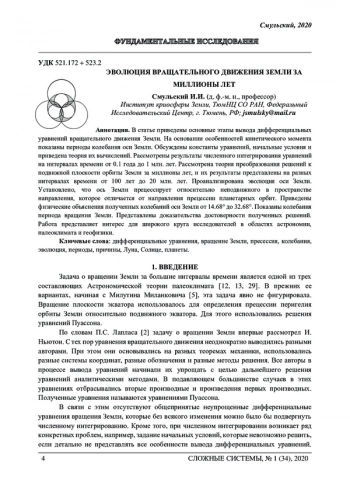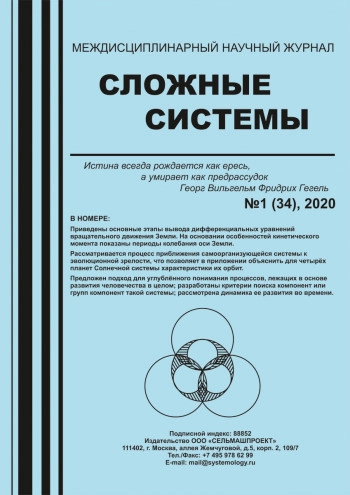В статье приведены основные этапы вывода дифференциальных
уравнений вращательного движения Земли. На основании особенностей кинетического момента
показаны периоды колебания оси Земли. Обсуждены константы уравнений, начальные условия и
приведена теория их вычислений. Рассмотрены результаты численного интегрирования уравнений
на интервалах времени от 0.1 года до 1 млн. лет. Рассмотрена теория преобразования решений к
подвижной плоскости орбиты Земли за миллионы лет, и их результаты представлены на разных
интервалах времени от 100 лет до 20 млн. лет. Проанализирована эволюция оси Земли.
Установлено, что ось Земли прецессирует относительно неподвижного в пространстве
направления, которое отличается от направления прецессии планетарных орбит. Приведены
физические объяснения полученных колебаний оси Земли от 14.68° до 32.68°. Показаны колебания
периода вращения Земли. Представлены доказательства достоверности полученных решений.
Работа представляет интерес для широкого круга исследователей в областях астрономии,
палеоклимата и геофизики.
There are the main points of the derivation of the differential equations of the Earth’s
rotational motion. The periods of oscillation of the Earth’s axis are grounded by the angular momentum
theorem. The constants of the equations, the initial conditions, and the theory of their computations are
discussed. The results of integrating the equations over time intervals from 0.1 year to 1 million years are considered. The theory of solutions transformation to the mobile plane of the Earth’s orbit is considered for millions of years, and the solution results are presented at different time intervals from 100 years to 20
million years. The evolution of the Earth’s axis is analyzed. It is established that the Earth’s axis precesses
with respect to a fixed direction in space, which differs from the direction of the precession of planetary
orbits. Physical explanations of the received oscillations of the Earth’s axis from 14.68° to 32.68° are given.
The oscillations of the Earth’s rotation period are shown. Evidence of the reliability of the solutions obtained is presented. The work is of interest to a wide range of researchers in the fields of astronomy, paleoclimate
and geophysics.
Идентификаторы и классификаторы
- SCI
- Науки о Земле



